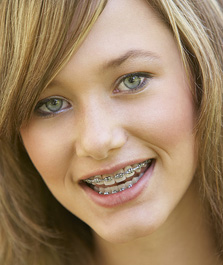Byron E. Diehl, DDS, MS
104 East Olive Ave, Suite 204
Redlands, CA 92373

Life with Braces
Eating with Braces
For the first day or so, soft foods are best. Avoid tough meats, hard breads, and raw vegetables. You'll need to protect your orthodontic appliances when you eat for as long as you're wearing braces. Dr. Diehl and his team will discuss more specifics and ideas when treatment starts.
Foods to Avoid
- Chewy foods: bagels, hard rolls, licorice
- Crunchy foods: popcorn, ice, chips
- Sticky foods: caramels, gum
- Hard foods: nuts, candy
- Foods you have to bite into with your front teeth: corn on the cob, apples, carrots
- Chewing on hard things (for example, pens, pencils or fingernails) can damage the braces. Damaged braces will cause treatment to take longer.
General Soreness
When you get your braces on, you may feel general soreness in your mouth, and your teeth may be tender to biting pressures for one to three days. This can be relieved by swishing warm salt water around in your mouth. Saltwater mouthwash: Dissolve one teaspoonful of salt in 8 ounces of warm water and rinse your mouth vigorously.
If the tenderness is severe, a pain relieving medication, what you would normally take for headache or similar pain, is fine to take. The lips, cheeks and tongue may also become irritated for a week or two as they become accustomed to the surface of the braces. You can put wax on the braces to lessen this irritation. We'll show you how!
Loosening of Teeth
If you notice that your teeth seem a little loose, don't worry, it’s normal! The teeth will again become rigidly fixed in their new – corrected – positions.
Loose Wire or Band
Don't be alarmed if a wire or band comes loose. This happens occasionally. If a wire protrudes and is irritating, use a blunt instrument (the back of a spoon or the eraser end of a pencil) and carefully push the irritating wire out of the way. If necessary, cutting a poking wire with small clippers is okay as well. If irritation to the lips or mouth continues, place wax or wet cotton on the wire to reduce the annoyance. Call our office for an appointment to check and repair the appliances. If any piece comes off, save it and bring it with you to the office.
Care of Appliances
To successfully complete the treatment plan, the patient must work together with the orthodontist. The teeth and jaws can only move toward their corrected positions if the patient consistently wears the rubber bands or other appliances as directed. Damaged appliances lengthen the treatment time.
Brushing
It's more important than ever to brush and floss regularly when you have braces so the teeth and gums are healthy after orthodontic treatment. Patients who do not keep their teeth clean may require more frequent visits to the dentist for a professional cleaning. Adults who have a history of gum disease should also see a periodontist during orthodontic treatment.
The intended animation requires a newer version of Adobe Flash® Player. Please visit www.adobe.com to download the latest version.
Brushing: Step 1
Using a dry brush with a small amount of toothpaste place bristles where gums and teeth meet.
Brushing: Step 2
For 10 seconds on each tooth use circular, vibrating motions around the gum lines.
Brushing: Step 3
Every tooth of both arches should be brushed slowly.
Brushing: Step 4
Brush the lower teeth from gum line up and the upper teeth from the gum line down. Brush the roof of your mouth and your tongue too!
Flossing: Step 1
Carefully thread unwaxed floss between braces and wire. You may find a floss threader helpful.
Flossing: Step 2
Carefully floss around the braces.
Flossing: Step 3
Carefully floss around the gum areas.
Flossing: Step 4
Carefully floss around each tooth.
Athletics
If you play sports, it's important that you consult us for special precautions. We recommend that you wear a protective mouthguard for contact sports. Dr. Diehl provides mouthguards at no cost. Ask an assistant for one and they will help fit you with a properly sized guard. In case of any accident involving the face, check your mouth and the appliances immediately. If teeth are loosened or the appliances damaged, call our office–or if after hours, our emergency line—immediately for an appointment. In the meantime, treat your discomfort as you would treat any general pain or soreness.